To view the Song of the Basque online collection, click here
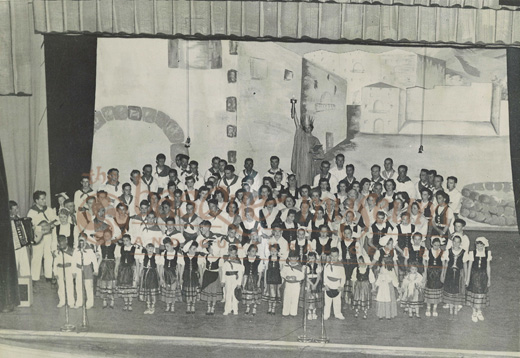
Entire cast of Music Week 1949 “Song of the Basque” Boise High Auditorium, performing “Gora America” (God bless America). Juanita Uberuaga, Espe Alegria, Ramon Echevarria, (guitar) Jimmy Jausoro (accordion) on the left side. Backdrop, painted by Miss Rosita Alegria. Juanita Uberuaga Hormaechea Collection, Vol. 28 P. 52.
Song of the Basque was a music and dance performance produced and directed by Juanita Uberuaga on May 9-10 (and repeated on May 20th due to public demand), 1949, and May 18th of 1950, for the Boise Music Week Festival in Boise, Idaho. The performance featured about 200 Idaho Basques of all ages from the entire Basque community of Boise. The show was a huge success in the Boise Music Week Festival, attracting around 4000 spectators the first year. It was a clear representation of the social acceptance of the Basque immigrants in Boise.
Boise Music Week was created by Eugene A. Farner, director of musical activities at St. Michael’s Episcopal Cathedral and St. Margaret’s School (now Boise State University) in 1919 as an annual event for local performers to show their talents. It was also entirely free to thepublic1. Different national communities of Boise took part in the festival. The Song of the Basque presented 200 Basques in native costumes, ranging in age from 3 years of age to performers over seventy years old.
Background
The first Basque dance group in Idaho was created in Emmett in the 1940’s due to Basque parents’ concern about the inability of younger Basques to perform ethnic dances. During those years, the annual Sheepherders Balls, and other dance performances were coming into play, like the International Program presented by the Columbian Club. By 1948, Juanita Uberuaga Aldrich Hormaechea, known as Jay Hormaechea, started giving dancing lessons to the Basque children of Boise. Later on these children would grow to become the first Oinkari dancers. Through those early efforts, Jay was the key to the future of Basque dancing in Boise and surrounding areas. She was also the first to produce an entire dancing and music performance for the Music Week Festival with the entire Basque community of Boise taking part. According to the original text of the album:
“Juanita directed the entire production, Song of the Basque, and in addition taught the youngsters the dances and songs presented. Her tireless, selfless and patient efforts were an inspiration to the performers2″.
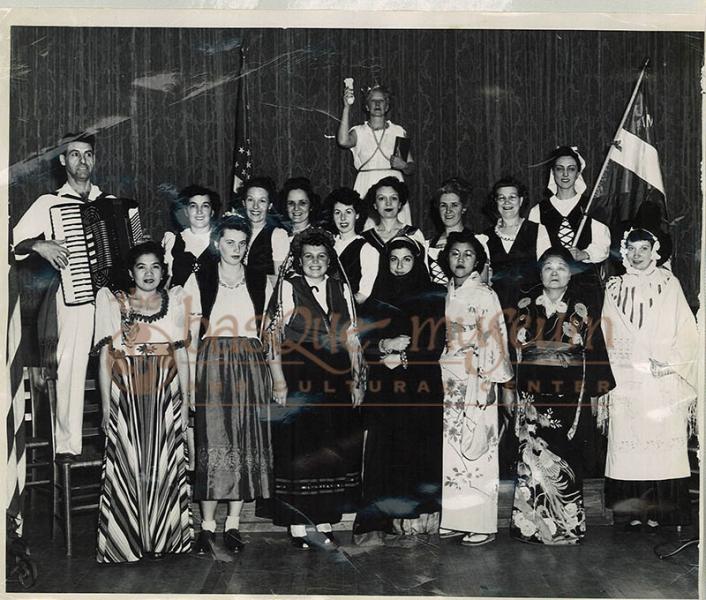
International Program Columbian Club, November 15, 1948. Basque women in the second row include Espe Alegria and Juanita Uberuaga and women of different nationalities. In the first row is Domingo Ansotegui with his accordion.
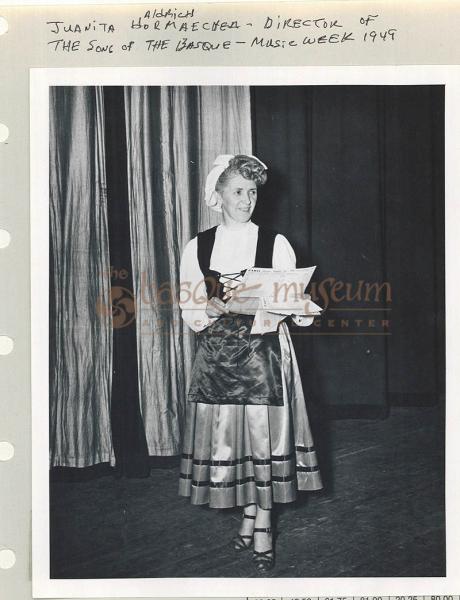
May 8, 1949. Mrs. Eugene Aldrich (Jay Uberuaga), Chairman of the program.
The production
The production was directed by Juanita Uberuaga after her experience teaching traditional dances to Boise’s Basque youth. However, without the help of many Basque protagonists, the show would not have been possible. Pete Leguineche served as narrator for the show and a very young and talented Rosita Alegria, daughter of the later famous broadcaster, Espe Alegria, painted the backdrop.
Among the performers were Mrs. Phil Uberuaga as a soprano, Miss Angela Bicandi and Miss Valen Letemendi on accordion, Antonio Villanueva and Ramon Aspiri on trumpets, the brothers Joe and Domingo Ansotegui, the Ysursa and the Anchustegui families, playing and singing well-known songs, Joe Anacabe, the Murelaga sisters with four year old Mary Murelaga singing and Josephine on accordion, and also Henry Alegria with his wife Espe. A special young men’s group called Los Borrachos was made up of Tony, Louie and Jimmy Jausoro as well as Julian Lachiondo, Johnny Elorriaga and Ramon Echevarria.
Although these were the most notable performers the entire cast of 200 performed with style and enthusiasm and credit was also given to those who worked behind the scenes to make the show possible.
A Basque parade on the streets of Boise with floats, dancers and musicians kicked off the performances both in 1949 and 1950.

Parade in1949.The float for the Music Week parade with Mrs. Angela Anacabe, Domingo Ansotegui (accordion), Ramon Echevarria (guitar) and Priscilla Saizar, facing camera.
The show
The performance premiered on May 9, 1949, at the Boise High School Auditorium at 8:15 pm. By 6:40 pm there were already hundreds of people outside waiting to get in. Many more were turned away as the auditorium was filled to capacity.

Schedule of the show
The show started with an old-country descriptive scene in the background painted by Rosita Alegria and a group of Basque women doing village work as they sang fishermen songs of Vizcaya; Neure Andria and Las Bilbainitas. Jai-Alai players then appeared, pantomiming the amazing pelota game while Joe Chacartegui in a comedic performance called out to the audience to bet on the players. Next, sixteen young, beautiful Basque girls danced a fast Jota and Porrasalda. This was the audience favorite according to the Idaho Statesman. The show continued with forty-five young Basque children in costume dancing and singing Aeroplano Bi Pasata and Artolako Dauko. Other performers included, Beatriz, and Pedro Anchustegui, Mercedes Bicandi, and the Mendiguren sisters, playing a duet of Malaguena on grand pianos.
A Basque interpretation of the famous Brahms lullaby melody was delivered in the “clear high soprano voice of Mrs. Marie Uberuaga”, according to the Idaho Statesman, “which rose up above the background chorus of the young girls”. Following her solo, a group of young women appeared in the shadows singing a melody about their fishermen husbands at sea: Itzasuan Llanu Dago. Suddenly the fishermen appeared in the scene and they broke into a joyous chorus and enthusiastic dancing of the Biribilketa. At the end of a spectacular program, the show closed with the patriotic songs Gernikako Arbola and Gora America (God Bless America) sungby all the performers.
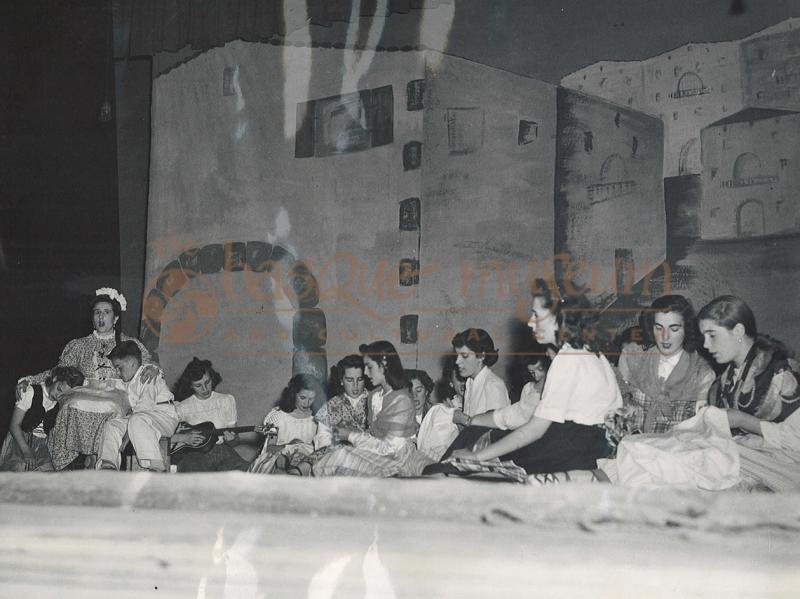
May 9th, 1950. The performing of Seaskan by Marie Uberuaga with the Basque chorus.
The entire performance on May 9th was recorded and produced an album, Song of the Basque2, comprised of eight dual-sided 78 rpm records by the The Allied Record Mfg. Company of Los Angeles. This collection became an instant classic in the homes of the Basque immigrants in Boise. This album has been recently digitalized and now is available in CD format at the Basque Museum and Cultural Center.
Here are the original descriptions of the songs recorded on the album:
“Neure Andria: A musical portrait, voiced by a group of the older Basques praising the work and charms of my (Neure) wife (Andria).
Los Bilbainitas: A song by the older group. It tells of the renewed friendships and the happy hours when a group of Basque fellows get together to sing songs and reminisce of days gone by.
La Jota: Sixteen beautiful Basque girls dressed in swirling scarlet skirts performed this swiftly moving “Jota”.
Porrasalda: A literal English translation of the word PORRUSALDA, (porro, leek and salda, soup) fails utterly to describe the color and perfect timing of this eye-catching native Basque dance.
Ama Seuriak: A plaintive story, set to music, of a boy singing to his sweetheart and asking: “Why did your mother pass me by on the street and did not even say hello? What wrong have I done?”
Seaska: The stage setting of twilight helped to effectively create the proper mood for this soft and delightful melody of the century-old lullaby. This (original) melody was the one from which Brahms was inspired to write his famous “Lullaby”.
Areoplano Bi Pasata (&) Artolako: Forty- five youngsters, ages four to fourteen, danced and sang like old troopers to these two tunes. Areioplano tells the story of two airplanes, one of which fell into the sea.
La Jota and Porrasalda: The youngsters stole the show with their own version of the La Jota and Porrusalda… The packed auditorium gave them a resounding ovation.
Itzasuan Llanu Dago (&) Biribilketa: A melody in a minor key accents the first part of this scene portrayed by the women mending fishing nets as they sing a yearning for their long-at-sea fishermen husbands… Part two of the song changes to a joyous chorus as the men return to their loved ones.
Gente Askok Esangothan: This last song is sung by the older, native Basque-born group.
*The information of the recording has been copied exactly from the original Album. Note that it was written before Euskera Batua was created, and the spelling of the Basque words was done phonetically.
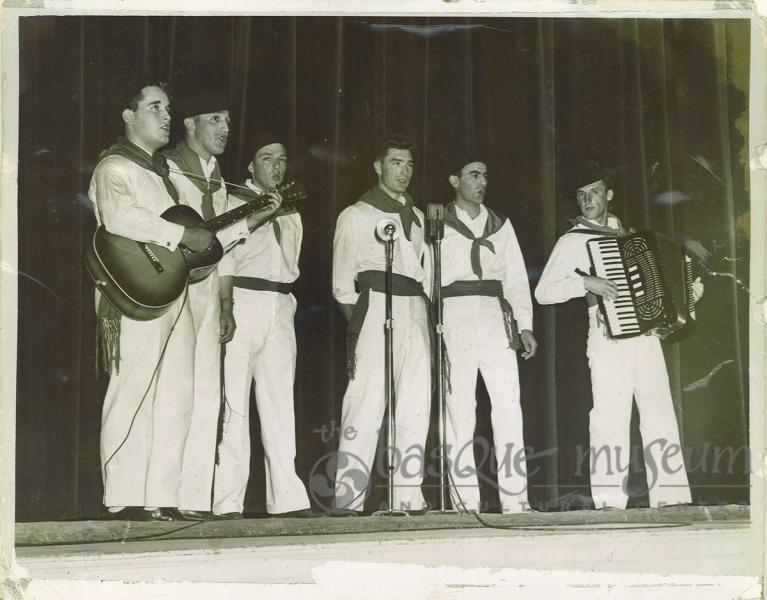
May 9th 1949. The group Los Borrachos, performing. From left to right: Ray Echevarria (guitar), Louie and Tony Jausoro, Johnny Elorriaga, Julian Lachiondo, and Jimmy Jausoro (accordion).
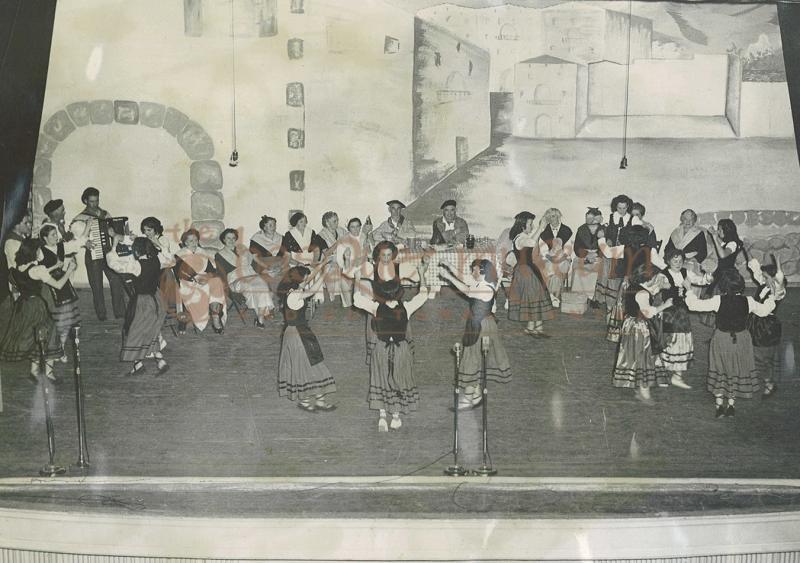
May 9th, 1949. Basque girls dancing the Jota and Porrasalda with the backdrop painted like a Basque village. 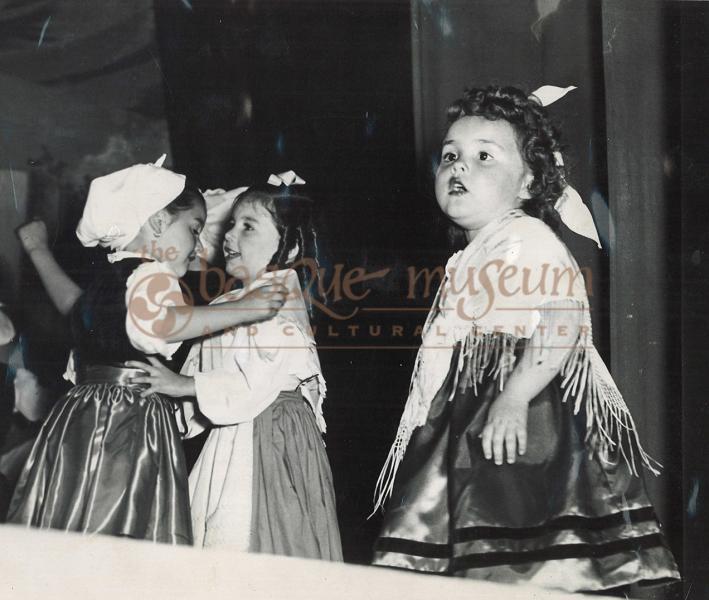
May 9th, 1949. Teresa Cengotita, Mary Murelaga, and Karen Luque dancing.
The success
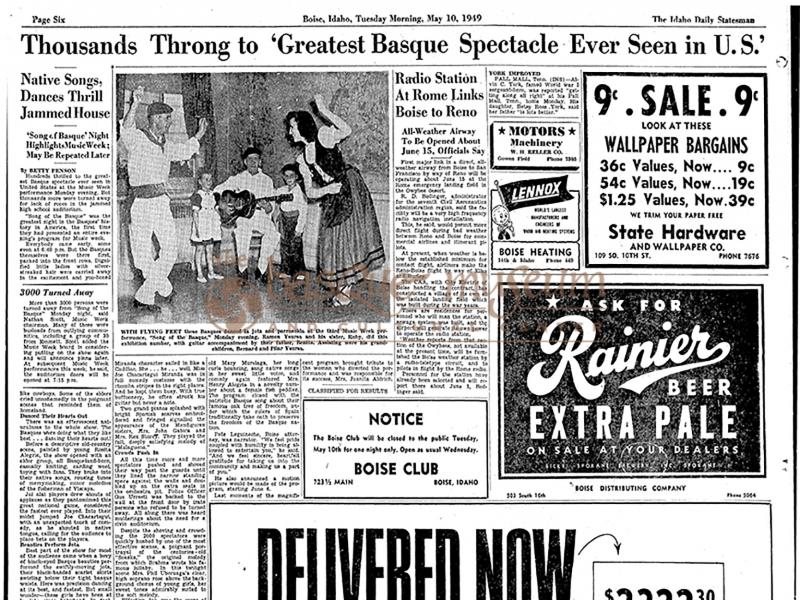
The Idaho Statesman, May 10, 1949. News about the successful show of May 9th with the Ysursa family performing in the photo.
“Thousands throng to ‘Greatest Basque spectacle ever seen in U.S ’” the Idaho Statesman proclaimed the day after the show. It was the highlight of Music Week and just one day later the Music Week Board announced that they were planning to repeat the show because about 3000 people were turned away from the Monday night performance. It was such a resounding success that program narrator, Peter Leguineche, announced that a movie of the show would be made. A total of over 4000 people attended the two performances
After this success, the Music Week Board sought sponsorship for a second date for the show on May 20th. Euzkaldunak, the Boise Basque organization covered the expenses for this performance since Community Chest funds were not sufficient to meet the cost of the show. This time around 1600 Boiseans came to see the pageant. The show was repeated the next year, 1950, on May 18th.
Song of the Basque was a great success thanks to the hard work of the Basque community in Boise. The result was the beginning of a Basque cultural “renaissance” in Boise and in Idaho. Song of the Basque was followed one year later by the building of the Basque Center on Grove Street in 1950, in the sixties, by the formation of the Oinkari Basque dance group and the consolidation of the Jim Jausoro Orchestra, which would be followed in the seventies by the creation of the Center for Basque Studies at Boise State University. It was also the precursor to the Basque Holiday Festival in 1972, a clear model for the currently successful Jaialdis. In summary, even though it was not the first Basque cultural gathering in Boise, the project of Juanita Uberuaga has come to be recognized over the years as the glorious start of many a successful Basque cultural project, not only in Boise, but in all the United States. Since by 1949, the Basque culture was slowly disappearing in the peninsular side of the Basque Country under the pressure of the darkest years of Franco’s dictatorship, the Song of the Basque had a profound meaning for the Boise Basque community and their acceptance by the greater Boise population.
Text by Eneko Tuduri.

Letter from Nathan Scott, General Chairman of the Boise Music Week to Jay Uberuaga.
1http://www.boisemusicweek.org/
2Song of the Basque, original music album. The Allied Record Mfg. Company of Los Angeles, California.
3 Idaho Statesman, May 10th, May 14th, May 21th, 1949.
Totoricaguena Egurrola, Gloria; Boise Basques: Dreamers and Doers. Vitoria Gasteiz: Central Publications Service of the Basque Government, 2002.
